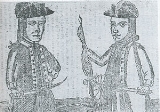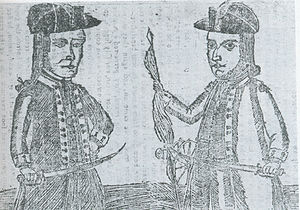
Job Shattuck
Encyclopedia
Job Shattuck of Groton, Massachusetts
was a Royal soldier in the French and Indian War who served in the 1755 campaign under Monckton in Nova Scotia, a colonial militia and Continental Army
officer during the war of the American Revolution
and, most famously, one of the key figures in the nation-defining 1786-87 farmer's revolt known to history as Shays' Rebellion
.

, the largest landowner in Groton with an estate comprising well over 500 acres (2 km²). At 19, Shattuck joined the royal military as a private in Captain Ephraim Jones’ company and took part in the battle at Annapolis Royal, Nova Scotia, on May 28, 1755. Two decades would pass before he again donned a uniform, this time eschewing the royal red coat of the British private for the homespun utilitarian attire of the colonial militiaman. Shattuck's wartime resume remains impressive. He participated in the Alarm of April 19, 1775, fought with noted distinction at Bunker Hill, added attrition during the Siege of Boston, led Groton men through the debacle at Ticonderoga and then to the triumph of Saratoga and was promoted to the rank of Captain by the State of Massachusetts in 1779. He was also elected town selectman of Groton on three occasions during the war.
Groton, Massachusetts
Groton is a town located in northwestern Middlesex County, Massachusetts. The population was 10,646 at the 2010 census. It is home to two noted prep schools: Groton School, founded in 1884, and Lawrence Academy at Groton, founded in 1793. The historic town hosts the National Shepley Hill Horse...
was a Royal soldier in the French and Indian War who served in the 1755 campaign under Monckton in Nova Scotia, a colonial militia and Continental Army
Continental Army
The Continental Army was formed after the outbreak of the American Revolutionary War by the colonies that became the United States of America. Established by a resolution of the Continental Congress on June 14, 1775, it was created to coordinate the military efforts of the Thirteen Colonies in...
officer during the war of the American Revolution
American Revolution
The American Revolution was the political upheaval during the last half of the 18th century in which thirteen colonies in North America joined together to break free from the British Empire, combining to become the United States of America...
and, most famously, one of the key figures in the nation-defining 1786-87 farmer's revolt known to history as Shays' Rebellion
Shays' Rebellion
Shays' Rebellion was an armed uprising in central and western Massachusetts from 1786 to 1787. The rebellion is named after Daniel Shays, a veteran of the American Revolutionary War....
.

Early life in Groton and military service
Shattuck was born in the rural central Massachusetts town of Groton in 1736, not long after the final Indian raids and skirmishes that had so often embattled the town during its early colonial period. His family occupied a large tract of land in the northwest corner of town, much of the acreage fronting the banks of the Nashua River. He would eventually become, through ultimogenitureUltimogeniture
Ultimogeniture, also known as postremogeniture or junior right, is the tradition of inheritance by the last-born of the entirety of, or a privileged position in, a parent's wealth, estate or office...
, the largest landowner in Groton with an estate comprising well over 500 acres (2 km²). At 19, Shattuck joined the royal military as a private in Captain Ephraim Jones’ company and took part in the battle at Annapolis Royal, Nova Scotia, on May 28, 1755. Two decades would pass before he again donned a uniform, this time eschewing the royal red coat of the British private for the homespun utilitarian attire of the colonial militiaman. Shattuck's wartime resume remains impressive. He participated in the Alarm of April 19, 1775, fought with noted distinction at Bunker Hill, added attrition during the Siege of Boston, led Groton men through the debacle at Ticonderoga and then to the triumph of Saratoga and was promoted to the rank of Captain by the State of Massachusetts in 1779. He was also elected town selectman of Groton on three occasions during the war.

